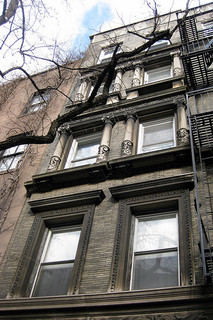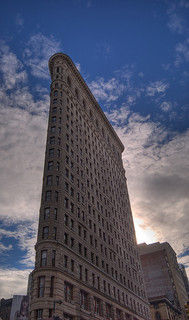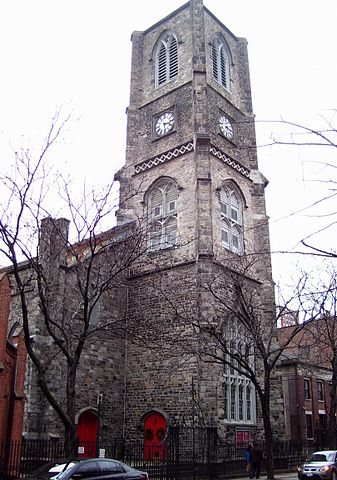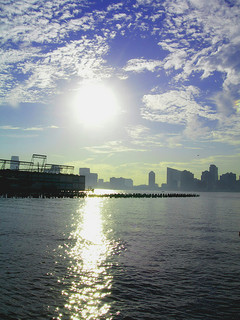Essay by Robert Boucheron
Becoming a Writer in 1980s New York
From 1981 to 1987, I lived in one room, a fifth-floor walk-up studio on West 16th Street in Manhattan. It had two windows facing south on the street side. Including the galley kitchen, bath, and light well, my studio mustered less than four hundred square feet. Still, I felt lucky to find it, a rent-stabilized unit.
 The building was an old brick tenement with four apartments on each floor. Mine was freshly renovated, with plaster walls painted white and a plywood floor. The landlord suggested that I install carpet. I bought vinyl tile, a can of adhesive, and a spreader, but not a proper utility knife.
The building was an old brick tenement with four apartments on each floor. Mine was freshly renovated, with plaster walls painted white and a plywood floor. The landlord suggested that I install carpet. I bought vinyl tile, a can of adhesive, and a spreader, but not a proper utility knife.
Directly above me was a flat roof. New Yorkers call such roofs, covered with layers of asphalt and felt and slightly pitched for drainage, “tar beach.” In fine weather, I took a folding chair up there to read. No one else came up, so I had the beach to myself.
The building was near Seventh Avenue in the part of Manhattan called Chelsea, just north of Greenwich Village. It shared that neighborhood’s good subway connections and ethnic diversity. Eighth Avenue, West 14th, and West 23rd were lined with shops, tall buildings, and institutions like the YMCA. The side streets were filled with buildings like the one I lived in: a few stories tall, old and unremarkable.
When I arrived in Chelsea, Eighth Avenue had a number of Cuban-Chinese restaurants, such as Asia de Cuba in its shiny Art Deco diner. Part of the post-Castro emigration, the mixed cuisine was spicy, greasy, and cheap.
With gentrification, the Cuban-Chinese restaurants disappeared. Row houses were renovated on the side streets. A sleek new building sprang up on Eighth Avenue. The arts moved in—galleries, boutiques, and the Joyce Theater. There was talk of adapting the vacant warehouses near the river. For the moment, Chelsea was Bohemia, as Greenwich Village had been decades before.
At eleven by seventeen feet, my room was larger than the house Thoreau built for himself on Walden Pond. In Walden, he describes the house, including these dimensions: “ten feet wide by fifteen long, and eight-feet posts.” Interestingly, he always calls it a house, never a cabin, shack, or hut. Situated in the woods, a mile from the town of Concord, it was embedded in Nature, not the Big City.
But on July 4, 1845, when he moved in, Thoreau was in his late twenties, as I was when I moved to Chelsea. We shared other traits: a Harvard education, self-sufficiency, and a taste for long, solitary walks. What he wrote in “House-Warming” applied to me:
“My dwelling was small, and I could hardly entertain an echo in it; but it seemed larger for being a single apartment. All the attractions of a house were concentrated in one room; it was kitchen, chamber, parlor, and keeping room; and whatever satisfaction parent or child, master or servant, derive from living in a house, I enjoyed it all.
Thoreau does not say so, but it was the only home he had to himself. Both before and after Walden, he lived in his parents’ house in Concord, or as a boarder. Growing up, I always shared a bedroom with a brother. Through college, graduate school, and my first years in New York, I had roommates. Like Thoreau, I longed for independence.
And, like Walden was for Thoreau, Chelsea was my experiment in living simply. There was no television, though I had my stereo LP player from college. I did not eat in fine restaurants, or attend galas, or ride in taxis. Like Thoreau, I took what was free, unadvertised, available to everyone. I became a connoisseur of the daily special, of what could be seen, heard, tasted, and touched without paying admission, in a city where everything was for sale.
To furnish my studio, I bought a raw pine table and shelves, which smelled wonderful and oozed sap from the knots. I bought a used chest of drawers, which I refinished. I found a small drop-front secretary on the street, worn but serviceable. I bought an old armchair, an early type of recliner called a Morris chair, invented by the English artist William Morris. Stripped of green paint, my Morris chair turned out to be made of mahogany, with front feet carved as lion’s paws. I acquired a mattress that rested on a low box of drawers. It was called a captain’s bed, with the long side meant to go against a wall.
I carried these things up to the fifth floor and arranged them in my room, like items stowed on a ship. In that respect, my captain’s bed was well named. I saw the merit of a place for everything and everything in its place, and I liked keeping my studio shipshape.
 When I moved to Chelsea, I was working full time as an architectural drafter for a large firm on East 39th Street in midtown. I walked to the office and home again, usually along Fifth Avenue. This route took me past two landmarks—the Flatiron Building and the Empire State Building—and countless examples of commercial architecture. The tide of fashion had ebbed from this part of New York, so the buildings had a vacant, dingy air. But there were hints of revival, new tenants here and there. I looked for these signs of life and for details of stone and terra cotta, cornices and railings, the endless variations of windows and glazing.
When I moved to Chelsea, I was working full time as an architectural drafter for a large firm on East 39th Street in midtown. I walked to the office and home again, usually along Fifth Avenue. This route took me past two landmarks—the Flatiron Building and the Empire State Building—and countless examples of commercial architecture. The tide of fashion had ebbed from this part of New York, so the buildings had a vacant, dingy air. But there were hints of revival, new tenants here and there. I looked for these signs of life and for details of stone and terra cotta, cornices and railings, the endless variations of windows and glazing.
Some years into my career, I became disenchanted. I took the license examination to qualify as an architect, failed as most candidates do, and neglected to try, try again. I drifted from job to job and eventually tried my hand at freelance drafting. There were plenty of firms in the city to generate work, and the hourly rate was enough to live on. And I had freedom to pursue an interest that had lain dormant since college: writing.
For the next three years, I wrote as much as possible every day. I wrote stories, character sketches, and novels. I read classic works of fiction, pored over favorite passages, and could not see how they were done. In dialogue, I found it impossible to make the characters sound natural. Description was my strong suit, I thought, until I saw that it must spur the action, or evoke an emotion, or explain a character. Movement was essential, but how to create it?
Some writer friends lived nearby. They were older, experienced, and had published books as small-press paperbacks. They had attended workshops and artist colonies like Yaddo. We never talked in depth about writing, and I failed to pick up any tips or techniques, with one exception. A judge’s clerk who had published a few poems and essays told me that each sentence should have an order, a crescendo, with the most important word at the end.
For exercise, and as a break from my work, I walked. Over the years, I traversed every street and avenue of Chelsea. The historic center is General Theological Seminary, which occupies one whole block bounded by Ninth and Tenth Avenues and by West 20th and 21st Streets. Laid out as a college campus, with lawns, large trees, and a Collegiate Gothic chapel in the middle, the seminary provides a rare green space in the city. The view from atop the chapel tower one January day was charming, if teeth-chattering. The surrounding streets are lined with nineteenth-century row houses, built of brick and brownstone, with stoops, tiny front yards, and restrained ornament.
Nearby stands St. Peter’s Episcopal Church, built in 1838 of gray stone, with a rectory of the same vintage. Picturesque and decaying, St. Peter’s is the earliest Gothic Revival structure in New York. It is also the parish of Clement Clarke Moore, generally considered to be the author of “Twas the Night before Christmas.” A professor at the seminary, Moore was an early developer of the neighborhood, which got its name from his estate, Chelsea.
 In the 1980s, St. Peter’s had a small congregation and struggled financially. Like a company taken into receivership, it was a “mission” of the diocese, no longer an independent parish. The vicar, Wray MacKay, with his white beard and jolly demeanor, gave an annual reading of the famous poem, a popular neighborhood event. I sang tenor in the choir, which on a good Sunday numbered eight voices. One morning, due to sickness and schedule conflicts, only two showed up, an alto and myself. We rearranged the anthem as a duet.
In the 1980s, St. Peter’s had a small congregation and struggled financially. Like a company taken into receivership, it was a “mission” of the diocese, no longer an independent parish. The vicar, Wray MacKay, with his white beard and jolly demeanor, gave an annual reading of the famous poem, a popular neighborhood event. I sang tenor in the choir, which on a good Sunday numbered eight voices. One morning, due to sickness and schedule conflicts, only two showed up, an alto and myself. We rearranged the anthem as a duet.
On Sunday afternoons, I walked west to the Hudson River and south to the Battery at the tip of Manhattan, a distance of a few miles. The elevated West Side Highway had been closed to traffic years before, and many of the piers were abandoned. In nice weather, the bare wooden piers functioned as a public beach, with sunbathers on towels, strolling peddlers, and bicyclists—but no swimmers in the polluted water. Traffic was sparse on Sunday, and it was pleasant to stroll along the post-industrial river.
At the Battery, the panorama of New York Bay opened out. New York possesses the finest and largest natural harbor on the East Coast, with sweeping views of water, sky, islands, and the Statue of Liberty. Brooklyn lies to the east, Staten Island to the south, and New Jersey to the west. They loom as vague masses rather than urban features. If weather permitted, I sat on a bench and stared at the immense scene, with the cliffs of Wall Street at my back. On wintry days, I scanned the view, then turned back to the city.
I varied my homeward route through the narrow, crooked streets of the financial district, deserted on Sunday. This is the oldest part of the city, settled by the Dutch in the early 1600s, continuously rebuilt and extended into the water, so that Pearl Street, for example, was once on the shore and is now well inland. Although historic, the area now seemed like an arid waste, with the sun and shade producing eerie effects in the artificial canyons.
As I walked north up Broadway, the landscape regained a human scale. Tribeca and Soho were redeveloping, peopled by loft dwellers, urban pioneers, and colonists of the middle class. By the time I passed Canal Street, the streets were lively with traffic, shops, and food vendors. Sidewalk hatches, steel grates, and glass-embedded pavement hinted at a subterranean world of vaults and tunnels. I explored this world once when working on an architectural project on Varick Street. It was as damp and creepy as a story by Edgar Allen Poe.
As time passed, I wondered about my lifestyle choice. Even the best freelance writers earn a precarious living. I would need to produce more polished stories and break into a better class of periodicals. As for architecture, I had shunted myself off the career track. Now in my thirties, I faced the prospect of reaching age forty still living in one room, walking the streets for lack of money or anything better to do. Poverty was becoming a strain, rather than a youthful ideal.
Thoreau mentions poverty in ways that suggest monastic asceticism. His experiment has the flavor of a religious retreat. Near the beginning of “Visitors,” he protests: “I am naturally no hermit.” Later, “Brute Neighbors” begins with a dialogue between “Hermit” and “Poet,” in which Thoreau seems to be the latter. He might more accurately call himself “Preacher.” The whole book has the sound of an outdoor sermon, where Paradise is the wooded shore of Walden Pond.
Why did Thoreau leave? After two years and two months, was the experiment a failure? He neglects to say that he recently suffered rejection by a woman to whom he proposed marriage, the death of a brother, a disappointing eight months in New York, and the shame of setting fire to 300 acres of woods near Concord. While celebrating solitude and self-reliance, Walden conceals sorrow and desperation.
 In the 1980s, the HIV-AIDS epidemic took hold of New York. Friends sickened and died, and the terrifying new disease became the sole topic of conversation. My circle of acquaintances melted away, as people moved out of the city or ended their lives in hospital beds. Healthy, I became isolated and depressed.
In the 1980s, the HIV-AIDS epidemic took hold of New York. Friends sickened and died, and the terrifying new disease became the sole topic of conversation. My circle of acquaintances melted away, as people moved out of the city or ended their lives in hospital beds. Healthy, I became isolated and depressed.
One day, my studio was broken into while I was at a laundromat. A young man in a hooded sweatshirt rushed past me down the stairs as I carried up a basket of clothes. My door was open, and my things were strewn over the floor. I had assumed that I had nothing to lose, but the burglar thought otherwise. He took clothes from the closet and my typewriter. My record player was unplugged and moved to the stairway hall.
My parents, meanwhile, had moved to rural Virginia, near family friends. They knew I was unhappy and urged me to join them. I visited and was charmed by the Blue Ridge. Surely, I could find a job nearby. The local phone book listed several architects. As my lease neared its annual renewal, I decided to give it up.
I phoned a moving company at random. I packed my books in cardboard boxes. I discarded manuscripts, notes, clippings, and back issues of Architectural Record. On a rainy morning in June, the movers lifted boxes and furniture and loaded their van. It took minutes, and they were gone. My belongings headed to a warehouse in Queens, to wait until the moving company had enough for a full load headed south.
I stood in the empty room where I had lived for six years. The vinyl tile had a gap along one wall. I had never finished cutting and laying the floor. The rain stopped, and the air was warm and sticky. I closed the window, picked up a small bag, and slid down the four flights of stairs for the last time.
I walked to West 14th Street and took the subway to Pennsylvania Station. There, I boarded a southbound train.
Art Information
- “NYC—Chelsea: 445 West 21st Street” © Wally Gobetz; Creative Commons license
- “Flatiron Building” © Andy Cross; Creative Commons license
- “St Peter’s Episcopal Church” © Beyond My Ken; Creative Commons license
- “Chelsea’s View” © Llima Orosa; Creative Commons license
 Robert Boucheron is an architect and freelance writer. Since 1987, he has lived in Charlottesville, Virginia, where he writes on housing, gardens, food, communities, and the people who build them. His work appears in Bloomsbury Review, Cerise, Country Living, Echo, New England Review, Northern Virginia, Piedmont Virginian, Rider, and Virginia Business.
Robert Boucheron is an architect and freelance writer. Since 1987, he has lived in Charlottesville, Virginia, where he writes on housing, gardens, food, communities, and the people who build them. His work appears in Bloomsbury Review, Cerise, Country Living, Echo, New England Review, Northern Virginia, Piedmont Virginian, Rider, and Virginia Business.
